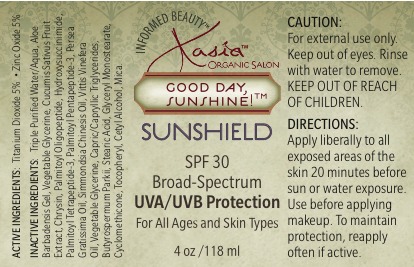Love and Protect Your Skin
May has already come and almost gone. With the sun shining more often (thank goodness), it seems appropriate that May is Skin Cancer Awareness Month. About two million people are diagnosed with skin cancer each year, making it the most common type of cancer in the United States.
Losing a brother at the age of 24 of skin cancer, this topic is near and dear.
However, it is also often a preventable type of cancer since the main cause is too much exposure to ultraviolet (UV) radiation from the sun. If it’s caught and treated early, skin cancer is very curable. But, all of us, regardless of skin color, should make protecting our skin and staying safe from the sun’s rays a priority and a daily habit.
Just how invasive has skin cancer become in the U.S.?
Check out these statistics from the Skin Cancer Foundation:
- Each year, over 5.4 million cases of non-melanoma skin cancer are treated.
- Melanoma rates are rising at an alarming rate among 18 to 39-year-olds.
- Over the past 40 years, skin cancer rates have grown by 800% among young women and 400% among young men.
So, what can you do to protect yourself?
Let’s start with the most obvious solutions: sunscreen.
How effective is sunscreen?
Yes, sunscreen will protect you from sunburn, but can it prevent skin cancer? According to a study from the Queensland University of Technology in Australia, when SPF 30-plus is properly applied, you’ll be protected 100% from all three types of skin cancer (melanoma, squamous cell, and basal cell). You have a cancer-fighting gene called P53 that protects us from all varieties of cancer, and sunscreen protects that gene, as well.
Preventing skin cancer helps prevent all cancer
The P53 gene works to heal our skin when it’s been sun damaged. If your skin gets burned regularly, the gene mutates and doesn’t do its job, which makes all kinds of cancer more likely to occur.
People who have had skin cancer are 15 to 26% more likely to develop other types of cancer in the future, so skin protection and regular skin checks are vital to your health. For us women, that means a higher risk of breast and lung cancer and non-Hodgkin’s lymphoma.
How deep does the damage go?
Obviously, when you’re skin gets burned, you can that damage has been done. What you might not know is that UV radiation damages our skin cells all the way down to the DNA, and it affects the protective functions of our skin. The way your skin cells make chemicals is changed by UVA and UVB rays. That’s why you get tan — your skin reacts to the sun’s rays by over producing melanin to protect itself. However, over-exposure to the sun results in melanin-producing skin cells to mutate and divide, and you end up with an uneven skin tone rather than a glowing tan.
Photoaging is the clinical term for the damage the sun does to your skin. Repeated exposure without protection causes your skin to become unable to repair itself. The damage doesn’t start in adolescence or young adulthood, either; it starts from infancy.
Sun and aging skin
Your skin needs collagen and elastin to be firm, smooth, and healthy. UV exposure breaks down collagen and elastin and makes them harder to synthesis. Without these supportive tissues, you’ll start to see wrinkles, sagging, and overall aging much faster than normal.
Your skin starts experiencing changes from the sun the moment it’s exposed to it, and over time those changes add up to a different look and feel. While you might think the changes are part of the normal aging process, they’re actually due to photoaging and are completely preventable.
Some of the skin issues you experience that are caused by photoaging are:
- Leathery texture
- Wrinkles
- Dryness
- Sagging
- Freckles, sunspots, appearance of blood vessels, and overall unevenness
- Skin growths
- Rough patches
How to get the glow without the damage
We all want to look like the healthiest and most attractive versions of ourselves, and a sun-kissed glow can give us that look. Wouldn’t it be nice if there was a solution that gives your skin and health protection from UV rays and also the color you desire? With the increase in skin cancer rates, we were inspired to create a solution to this problem, especially for us upper-midwest women.
Thanks to new technology and high-quality ingredients, our Evoq custom-formulated sunless tanner has become a top-seller nationwide through cult-favorite beauty blogs and local ladies alike. Our Evoq age-defying lotion is a natural, long-lasting, even-fading, quick-drying formula full of skin-enriching, organic, and nourishing ingredients.
Igniting the glow naturally
As a consumer, we know you’re a savvy shopper and look for multiple benefits from a single product. You now know the concerns of UV exposure in regards to accelerated aging and skin cancer, but you still want that healthy and radiant glow the sun is so good at giving.
Evoq’s sunless tanner formula contains a key ingredient called dihydroxyacetone (DHA) which reacts with dead skin cells on your body’s surface and darkens them naturally. Not only does it give you a safe and healthy glow, but the formula is boosted with anti-aging benefits that decrease fine lines and wrinkles, smooth your skin, and fight free radical damage.
The formula hydrates and nourishes your skin with antioxidants, plant extracts, and humectants. These ultra-hydrating extracts and anti-aging ingredients combined with the DHA’s tanning effects delivers a unique skin treatment. It’s a game-changer for sunless tanning as women become more aware of the dangers of the sun’s UV rays and embrace sunless tanning products.
No longer compromise on skincare to achieve a safe and natural-looking tan. You’ll get the radiant glow easily using healthy and natural ingredients in our sunless tan solution, plus you’ll enjoy soft, smooth, and nourished skin.
Show off your beautiful, bare legs with Evoq’s Sunless Tanner and protect your skin with our Tinted UV Primer. All of our products are created with organic, wild-craft, and food-grade ingredients.
Avoid harmful UV rays from the sun and tanning beds and still get beautifully bronzed skin. Natural sugars from beets and sugarcane (DHA) react with your skin’s surface to give you a safe and authentic-looking tan. Licorice and Aloe soothe, repair, and hydrate your skin to make it youthful and glowing. Super-fruit alpha and beta hydroxy acids exfoliate, eliminate blackheads, and fade existing sunspots.
Some of the other super-powered ingredients include:
- Sweet almond oil: fights wrinkles and diminishes scars and dark spots
- Gotu Kola: prevents premature aging and diminishes varicose veins and scars
- Papaya leaf: contains vitamins A and C for skin health and brightening qualities.
It’s super easy to apply by using gentle and even strokes. Depending on your glow, you can reapply every two to three days, or mix with your favorite moisturizer for a more subtle glow.
Hydrate: Tinted UV Primer 35 SPF
Get broad-spectrum protection from UV rays with a non-greasy, ultra-light sunblock. At the same time, your skin is primed for makeup and moisturizing. The 3-in-1 tinted primer also provides a shot of vitamin D for some healthy sunshine in a bottle. Vitamin D promotes a youthful complexion, builds your skin’s immunity, and provides a brightening glow to all skin types.
Use it daily under your makeup for a smooth finish and protected skin. Mix it with your liquid concealer or moisturizing, and it’s even safe to use for children as young as six months.
Enjoy the benefits of these active ingredients:
- Zinc Oxide 35 SPF: The best and safest UV protection for the whole family. Reduces aging and visibility of skin damage.
- Vitamin D3: Traditional sunscreens block your intake of this crucial vitamin, so we’ve infused it into our primer, so you still get it’s skin and internal health benefits while avoiding harmful UV rays.
- Organic sunflower seed: Rich in vitamin E to reduce the appearance of wrinkles and lighten scars and under-eye circles.
- Shea butter: Healing, anti-inflammatory hydrator that fights blemishes.








